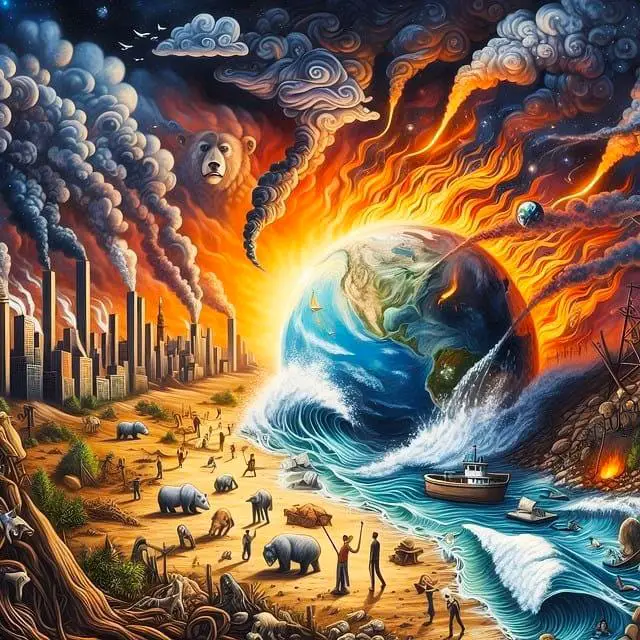Climate Change : Meaning, Cause’s, Chareteristic’s, Type’s & Remedie’s
Climate Change : Meaning, Causes, Characteristics, Types & Remedies
Climate change refers to long-term shifts in temperature, weather patterns, and atmospheric conditions, particularly those caused by human activities. It affects ecosystems, weather systems, biodiversity, and human life across the globe.
1. Meaning of Climate Change:
Climate change is the significant and lasting alteration of global or regional climate patterns. Although climate change can occur naturally over geological time scales, current global warming trends are primarily driven by human activities, particularly the burning of fossil fuels, which increase concentrations of greenhouse gases (GHGs) in the atmosphere.
- The term is often used interchangeably with global warming, which refers to the rising global average temperatures. However, climate change encompasses a wider range of changes, including changes in precipitation patterns, rising sea levels, and more frequent extreme weather events.
2. Causes of Climate Change:
The causes of climate change are primarily related to human activities that disturb the natural balance of the Earth’s climate system, alongside some natural factors.
Human-Induced Causes:
- Greenhouse Gas Emissions:
- Burning Fossil Fuels: The combustion of coal, oil, and natural gas for energy production, transportation, and industrial processes releases large quantities of carbon dioxide (CO₂), methane (CH₄), and other greenhouse gases into the atmosphere.
- Deforestation: Forests act as carbon sinks, absorbing CO₂ from the atmosphere. Deforestation reduces the Earth’s capacity to absorb carbon, while also releasing CO₂ stored in trees.
- Agriculture: Livestock farming produces methane, a potent greenhouse gas. The use of nitrogen-based fertilizers also leads to the release of nitrous oxide, another GHG.
- Industrial Processes: Industrial activities like cement production and chemical manufacturing release GHGs and pollutants.
- Waste: Decomposing organic waste in landfills produces methane, while poor waste management practices exacerbate environmental pollution.
- Urbanization:
- The expansion of urban areas increases energy consumption, leading to greater emissions from heating, cooling, and transportation. Additionally, urban sprawl increases the demand for natural resources and alters land use patterns.
- Transportation:
- Vehicles powered by fossil fuels (gasoline, diesel) emit CO₂ and other GHGs. The rapid increase in global transportation, including air travel, is a significant contributor to emissions.
- Energy Production:
- The continued reliance on non-renewable energy sources like coal, oil, and natural gas contributes to climate change. Energy production accounts for a large percentage of global GHG emissions.
Natural Causes:
- Volcanic Eruptions:
- Large volcanic eruptions can inject aerosols and gases like sulfur dioxide into the atmosphere, which can reflect sunlight and temporarily cool the Earth. However, this effect is short-lived and does not cause long-term climate change.
- Solar Variability:
- Changes in solar radiation, caused by variations in the sun’s energy output, can influence the Earth’s climate. However, current warming trends are not primarily driven by solar activity.
- Earth’s Orbital Changes:
- Natural shifts in the Earth’s orbit and axial tilt (Milankovitch cycles) affect the distribution of solar energy, leading to natural cycles of ice ages and warmer periods over tens of thousands of years.
3. Characteristics of Climate Change:
Climate change exhibits several defining characteristics that distinguish it from short-term weather fluctuations.
- Rising Global Temperatures:
- Global average temperatures have been rising steadily since the industrial revolution due to increased greenhouse gas concentrations. The last decade was the warmest on record, with 2020 tying as one of the hottest years ever recorded.
- Melting Polar Ice and Glaciers:
- The Arctic and Antarctic ice sheets, as well as glaciers around the world, are melting at unprecedented rates due to rising temperatures. This contributes to sea level rise and the loss of habitats for polar species.
- Rising Sea Levels:
- Melting ice and the thermal expansion of seawater as it warms contribute to rising sea levels. This threatens coastal communities, low-lying islands, and ecosystems.
- More Frequent Extreme Weather Events:
- Climate change increases the frequency and intensity of extreme weather events such as heatwaves, hurricanes, typhoons, floods, and droughts. These events lead to significant economic, social, and environmental impacts.
- Ocean Acidification:
- As oceans absorb excess carbon dioxide, they become more acidic, which affects marine life, particularly organisms with calcium carbonate shells, such as coral reefs and shellfish.
- Disruption of Ecosystems and Biodiversity:
- Many species are struggling to adapt to the rapid changes in temperature and habitat conditions, leading to shifts in migration patterns, food availability, and an increased risk of extinction.
- Impact on Agriculture and Food Security:
- Changing rainfall patterns, increasing temperatures, and more frequent droughts and floods negatively impact agricultural productivity, threatening global food security.
4. Types of Climate Change:
Climate change can be categorized based on its causes and impacts:
Based on Causes:
- Natural Climate Change:
- These are changes in the Earth’s climate due to natural phenomena such as volcanic activity, variations in solar energy, and orbital shifts.
- Examples: Ice ages, natural warming periods.
- Anthropogenic (Human-Induced) Climate Change:
- This refers to the climate change caused by human activities, particularly since the industrial revolution, when the burning of fossil fuels and deforestation became widespread.
- Examples: Current global warming trends, rising CO₂ levels due to industrial activities.
Based on Impacts:
- Global Warming:
- The increase in Earth’s average surface temperature due to the accumulation of greenhouse gases. This is the most widely recognized form of climate change.
- Changes in Precipitation Patterns:
- Some regions experience more intense rainfall and flooding, while others experience prolonged droughts and decreased water availability.
- Extreme Weather Events:
- Climate change increases the intensity and frequency of extreme weather events, such as hurricanes, typhoons, and tornadoes.
- Oceanic Changes:
- Changes in ocean temperatures and currents, such as the weakening of the Gulf Stream, can alter weather patterns and disrupt marine ecosystems.
5. Remedies for Climate Change:
Addressing climate change requires a combination of mitigation strategies (reducing the causes) and adaptation strategies (adjusting to the impacts).
Mitigation Strategies (Reducing Causes):
- Transition to Renewable Energy:
- Shifting from fossil fuels to renewable energy sources like solar, wind, hydro, and geothermal reduces greenhouse gas emissions.
- Example: Expanding solar and wind farms to provide clean electricity.
- Energy Efficiency:
- Improving energy efficiency in homes, industries, and transportation can significantly reduce energy consumption and emissions.
- Example: Using energy-efficient appliances, LED lighting, and electric vehicles.
- Carbon Pricing:
- Implementing carbon taxes or cap-and-trade systems puts a price on carbon emissions, incentivizing companies to reduce their carbon footprint.
- Example: The European Union’s Emissions Trading System (EU ETS).
- Afforestation and Reforestation:
- Planting trees and restoring forests can absorb CO₂ from the atmosphere, acting as carbon sinks.
- Example: The “Billion Tree” reforestation initiatives worldwide.
- Reducing Industrial Emissions:
- Industries can adopt cleaner technologies and switch to low-emission processes.
- Example: Using carbon capture and storage (CCS) technologies in power plants.
- Sustainable Agriculture:
- Reducing emissions from agriculture by promoting sustainable practices such as organic farming, reducing fertilizer use, and improving livestock management.
- Example: Agroforestry, crop rotation, and precision farming.
- Reducing Waste and Promoting Recycling:
- Managing waste through recycling and reducing landfill usage can reduce methane emissions.
- Example: Zero-waste initiatives and composting programs.
Adaptation Strategies (Adjusting to Impacts):
- Building Climate-Resilient Infrastructure:
- Coastal areas can construct seawalls, flood barriers, and other infrastructure to protect against rising sea levels and extreme weather events.
- Example: Cities like New York and Tokyo building flood defenses.
- Water Conservation and Management:
- Managing water resources through efficient irrigation systems, water recycling, and rainwater harvesting can help regions facing droughts.
- Example: Drip irrigation and desalination plants.
- Disaster Preparedness:
- Governments and communities can develop disaster management plans to respond to extreme weather events.
- Example: Early warning systems for hurricanes and floods.
- Protecting and Restoring Ecosystems:
- Restoring wetlands, mangroves, and coral reefs can enhance natural defenses against climate impacts and protect biodiversity.
- Example: Mangrove restoration projects in coastal areas.
- Improving Agricultural Resilience:
- Farmers can adopt drought-resistant crops and new farming techniques to maintain productivity under changing climatic conditions.
- Example: Developing heat-tolerant crop varieties.
Conclusion:
Climate change is one of the most pressing global challenges of our time, driven primarily by human activities like fossil fuel consumption and deforestation. Its causes, characteristics, and types underscore the need for urgent global action through mitigation and adaptation strategies. Reducing greenhouse gas emissions, transitioning to renewable energy, protecting ecosystems, and building resilience to its effects are essential steps to combat climate change and ensure a sustainable future for all.











Leave a Reply